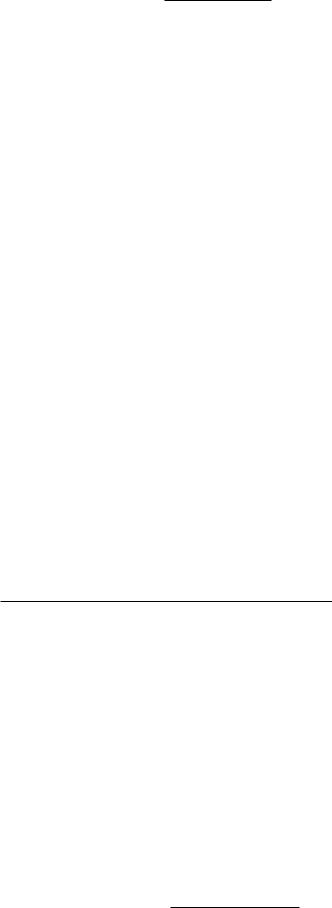
CFA Level 1 (2009) - 3
.pdf
Study Session 8
Cross-Reference LO CFA Institute Assigned Reading #34 - Understanding dJe Cash Flow Statement
--------~--------- ---------
LOS 34.b: Describe how noncash investing and flnancing activities are reponed.
---- --------------
Noncash investing and financing activities arc not reporled in the cash How statement since they do not result in inflows or outflows of cash.
For exampl<:, if a fIrm acquires real estate with financing provided by the seller, the
firm has made an investing and fInancing decision. This transaction is the equivalent of horrowing rlw purchase price. However, since no cash is involved in the transaction, it is not reported a.s an investing and financing activity in the cash Aow statemcnt.
Another example of a noncash rransacrion is an exd1ange of debt for equity. Such an exchange results in a reduction of debt ami an increase in equity. I Iowevcr, since no cash is involved in the transaction, it is not reported as a financing activity in lhe cash flow statement.
Noncash transactions I1Just be disclosed in either a hJOtnore or supplemental schedule to the cash now statunent. Allah'sts should be aware of rite linn's noncash transactions,
incorporate them inlO analysis of past and currem performance, and include their effects in estimating fUlure cash Hows.
LOS 34.c: Compare and contrast the key differences in cash flow statements prepared under int<:rnational hnancial reporting standards and generally accepted accounting principles.
Recall from Figure 1 that under U.S. GAAP, dividends paid to the firm's shareholders are reponed as financing activities while interest paid is reponed in operating activities. Interest received and divillends received from investlllcnrs arc also reponed as operating aCr!Vlues.
Inrernational Financial Reponing Standards (IFRS) allow more flexibility in the classification of cash flows. Under IFRS, interest and dividends received may be classified as either operating or investing activities. Dividends paid to the company's shareholders and imerest paid on the company's debt may be classified as either operating or financing ~1Clivilics.
Another important difference relates to income taxes paid. Under U.S. GAAP, all taxes paid are reported as operating activities, even taxes related to investing and financing transactions. Under IFRS, income taxes are also reponed as operating activities unless the expense is associated with an investing or financing transaction.
foor example, consider a company that sells land that was held for investment for $1 million. Income taxes on the sale total $160,000. Under U.S. GAAP, the firm repons an inflow of cash from investing activities of $1 million and an outflow of cash from operating activities of $160,000. Under IFRS, the firm can reporr a net inflow of
$840,000 from investing activities.
©2008 Kaplan Schweser |
Page 1 11 |

Study S~ssion 8
Cross-Reference to CI~ Institute Assigned Reading #34 - Understanding the Cash Flow Statement
LOS Yi.d: Demonstrate the difference between the direct and indirect methods of presenting cash from operating activities and explain the arguIl1eIfts in bvnr or each.
There are two methods of presenting the cash How statemen t: the direct mcthod and the indircct mcthod. Both methods arc permittcd undcr u.s. GAAP and IFRS. Thc usc of the dircct method, howcvcr, is encouraged by bmh st3.nd3.rd setters. The diHcrence in the two meth.ods relates to the presentation of cash How from operating activities. The presentation of cash flows from investing activities and financing activities is exacdy the same under both methods.
Direct Method
Under the direct method, each linc item of the accru:ll-based income statement is converted into cash receipts or cash payments. Recall that under the accrual method of accounting, the timing of rcvenuc and expense recognition may diffcr from the timing of thc related cash Hows. Under cash-basis accounting, revcnuc and expense rccognition occllr when cash is received or paid. Simply stated, thc direct method converts an accrual-basis income statcment imo a cash-basis incomc statcment.
Figure 2 contains an example of a presentation of operating cash flow for Seagraves
Supply Company using the direct method.
Figure 2: Direct Method of Presenting Operating Cash Flow
Seagraves Supply CampallJ
Opcmting Cm/; FloUJ - |
Direct lvfn/;od |
|
For the year endfd December 31, 20X7 |
||
|
|
|
Cash collections from customers |
$429,980 |
|
Cash paid to suppliers |
(265,866) |
|
Cash paid for operating expenses |
(124,784) |
|
Cash paid for interest |
(4,326) |
|
Cash paid for taxes |
04,956) |
|
Operating cash flow |
$20,048 |
|
|
|
|
Notice the similarities of the direct method cash flow presentation and an income statement. The direct method begins with cash inflows from customers and then deducts cash outflows for purchases, operating expenses, interest, and taxes.
Indirect Method
Under the indirect method, net income is converted to operating cash flow by making adjustments for transactions that affect net income but are not cash transactions. These adjustments include eliminating noncash expenses (e.g., depreciation and amortization), nonoperating items (e.g., gains and losses), and changes in balance sheet accounts resulting from accrual accounting events.
Figure 3 contains an example of a presentation of operating cash flow for Seagraves
Supply Company under the indirect method.
Page 112 |
©2008 Kaplan Schweser |

Srudy Session 8
Cross-Reference to CFA Institute Assigned Reading 1134 - Understanding the Cash Flow Statement
Figure 3: Indirect Method of Presenting Operating Cash flow
----------
Serlgrrllles SllPP~Y Company
|
0pt'/"flting CtlJh now - |
Indirect Method |
||
|
For tlu' y,'tJr mdd J)1'Ct'mba 31, 20X7 |
|||
|
|
|
|
-------~--~~--- |
Nct incomc |
$18,788 |
|||
Adjustmcnts to rcconcile nct incomc to cash |
||||
How providcd hy operating activitics: |
|
|||
Deprcciation ami amortization |
7,9% |
|||
Deferred incomc taxes |
41G |
|||
Increase in accounts receivable |
(1,220) |
|||
Incn:asc in inventory |
(20,544) |
|||
Decrcase in prepaid cxpcnscs |
4')4 |
|||
Increase in accounts payahle |
13,'\06 |
|||
Increase in accrued liahilitics |
|
|||
|
|
|
|
S20,(H8 |
|
|
|
|
|
Notice that under the indirect method, the starting point is net income, the "boltom line" of the income statement. Under the direct method, the starting point is the top of the income statement, revenues, adjusted to show cash received from customers. Total cash flow from operating activities is exactly the same under both methods, only the presentation methods differ.
Arguments in Favor of Each Method
The primary advantage of the direct method is that it presents the f1rm's operating cash receipts and payments, while the indirect method only presents rhe net result of these receipts and payments. Therefore, the direct method provides more inforntation than the indirect method. This knowledge of past receipts and payments is useful in estimating future operating cash flows.
The main advantage of the indirect method is that it focuses on the differences in net income and operating cash Row. This provides a useful link to the income statement when forecasting future operating cash Row. Analysts forecast net income and then derive operating cash flow by adjusting net income for the differences between accrual accounting and the cash basis of accounting.
Disclosure requirements
Under U.S. GAAp, a direct method presentation must also disclose the adjustments necessary to reconcile net income to cash flow from operating activities. This disclosure is the same information that is presented in an indirect method cash How statemen t. This reconciliation is not required under IFRS.
Under II~RS, payments for interest and taxes must be disclosed separately in the cash flow statement under either method (direct or indirect). Under U.S. GAAP, payments for interest and taxes can be reported in the cash How statement or disclosed in the footnotes.
©2008 Kaplan Schweser |
Page 113 |

Study S<:~~iol1 8
Cros~-Rcfcrence to CFA Institute Assigncd Reading #34 - Undcrstanding the Cash Flow Statclllclll
LOS :H.e: DemoIlSlratc how the cash flow statement is linked to the income stalenleIll and baLlIlCe sheet.
The clsh /low slateI1\ent reconciles the beginning and ending baLlIlces or cash over an accounting period. The change in C1sh is a result of the GrIll's operaling, investing, and fInancing auivilies ;IS (ollows:
Operating cash flow
+Investing cash /-low
;.Financing cash flow
-TIaI1ge In cash baT..1ncc-
Beginning cash babnce
TndlI1gcash halancc--
It is important to understand that nCI incoI1\c, bascd on Jccrual accounting, is not the SJme thing JS cash earnings, When thc liIlliug of reVCllue or npense recognition differs I'rom tile receipt or paymenl of cash, it is rdkclcd in changcs in h;~lancc sheel accounls,
For example, when revcllucs (sales) exceed clsh collections, ,lecounls receivable increasl'. The opposite occurs when cash collections exceeJ rcvcnues; accounts receivable (J.n Jsset) decrease. When purchJses from suppliers exceed cash payments, accounts payable (a liability) increase. When cash payments exceed purchases, payables decrease.
Investing activities typically rclate to activities lypically relate ro the firm's
the firm's noncurrent assets, while financing noncurrent liabilities and equity.
Each balance sheet account can be analyzed in terms of the transactions that increase or decrease the account over a period of time. For example, the following is a reconciliarion of inventory:
Beginning inventory balance
+Inventory purchases Cost of goods sold
Endll1g lllvenrory balance
Professor's Note: Given three of the fimr uariabLes in the abo1)e reconciliation, it is easy to soLve for the fourth. This type ofanaLysis can be applied to any
baLance sheet account as Long as you /mow which transactions increase and which transactions decrease the {[ccounl.
The firm's balance sheet, income statement, and cash flow statement are all related. Understanding these relationships is important for analytical purposes, as well as for detecting possible aggressive accounting pracrices.
Page 114 |
©2008 Kaplan Schweser |

5tl1dy Scs~ion 8
Cross-Reference to CFA Institute Assigned Reading #34 - Understanding the Cash Flow Statement
l.()~'; .).1.1": |
J)ClIlo'ISlr;I\C lhc stcps ill |
the pfcparatilill oj" dill;ll ;llld illdill'li 1.:1:,ll |
||||
Illlb'SLIU'IIIClllS, illdudillg ho\\' L\.,ll |
OO\\'sCIII bc lOJllpUICd ll\lll,~ l'ICUil1t" |
|||||
~.. ;t[l'''llJl\ |
dlld I>:lhllll' ~,11l'l1 lhl<l. |
|
|
|
|
|
|
|
|
|
|
|
|
flroji'ssor's Notl': 'luo/ig/JOllt the r1isl"/lssio/1 a/the clirl'ct f/lld il/(lil'I'Ct IlIl'thor!s, remcmber the fiJI/owing poi II!J:
df,-"~~}
,o• ."'.-J
.. .-::"
• CFO is crllcllifttecl cltjJl'rently, but the r1'5ult is thl' Sill1le ullder both methocls.
•T/H calculation ofCF1 anti CFF is identicaL under bot/J methods,
•Therl' is an iJwerJl' rl'Lations/Jip betwan changes in assets flJld changl's in
|
cash flows. In other wordj', flll increme in an tlssl't accollnt is a |
1I5e of cash, |
||
|
and a darN/51' ill fIJI asset tlCCOlillt is tl source Of cash . |
|
||
• |
nJne iJ {/ |
direct relationship |
bt'twi't'Il changes ill liabilities alld changes in |
|
|
CflSh flow. |
1/1 other words, fill |
illcreflsl' in a liability flU'OUllt is |
fl sourre oj' |
rmh, and (/ deCl"ctlse ill a lif/bility is a lise of cash.
•SO/lrCe'S olu/sh arc pmitiue lIulI/ben (rm/J i/~(l()ws) ai/rillses o(ctlJh flrl'
IICgtllit l l' 1111/11 hers (c!ljh Oil t(lows).
Direct Method
The direct medlOJ of present a firm's statement of cash flows shows only cash payments and cash receipts over the period. The sum of these inflows and outflows is the company's CFO. The direct method gives the analyst more information than the indirect method. The analyst can see the acmal amounts that went to each usc of cash and that were received from each source of cash. This information can help the analyst to better understand the firm's performance over time and to forecast future cash flows.
The following are common components of cash flow that appear on a statement of cash flow presented under the direct method:
• |
Cash collected from customers, typically the main component of CFO. |
• |
Cash llsed in the production of goods and services (cash inputs). |
•Cash operating expenses.
Cash paid for j n teres\.
•Cash paid for taxes.
Profissor's Note: A common "trick" in direct method questions is to provide infOrmation on depreciation expense aLong with other opaating cash flow components. When using thl' dirl'Ct method, ignore depreciation expense-it's a noncash charge. We'LL see Later that we do consider depreciation expense in
indirect method computations, but we do this soLI'Ly becausl' depreciation expense and other noncash expellSes htlve ban subtracted in calcuLating net income (our starting point) and need to be added back to get cash flow.
Investing cash flows (CFI) are calculated by examining the change in the gross asset accounts that result from investing activities, such as property, plant, and equipment,
©2008 Kaplan Schwescr |
Page /15 |

SUloy Session 8
Cross-Reference to CFA Institute Assigned Reading #34 - Understanding the Cash Flow Statement
intangibk asscts, and investment securities. Related accul11ubteu depreciation or amonization accounts are ignored since they do not represent cash expenSl:s.
,:"'> J>rojl>Horj' |
Note: 111 this COli text, ''gross'' simp0' mI'II'H (/11 fllt/Ollllt that is' |
|
(~ |
prtsl'lItl'd |
~fJ the balllll(l' sh('('t bijilre dl'ductillg allY a(cllmlliated tlepr(rifltioII or |
amorflUI t/OII.
Whl:n calculating cash paid for a nl:\V aSSl:t, it is necessary to dncrminc whether old assets wcre sold. If assets were sold during the period, you must use the following formula:
cash paiu for new assct = cnding gross asscts + gross cost of old assets sold - beginning gross asscts
Projl'sSor) Note: it nl/IY be c(15ier to think in terms ofth( i/(count reconciliatiol/ 'I1111I i.i, begilillilig gross (ISS(tS + (m!J /lIIid/or 111'1<' (lSsets '0 em/ing gross IIJSl'tS. (;i/l1'1I thrt'C ofthl' 11(lI'iilbll's. simpl)1
.\ol/le Jln' ti,e fOlll'th.
When calculating the cash flow from an asset that has been sold, it is neCl:ssary to consider any gain or loss from the sale using the following formula:
cash from asset solu = book value of the asset + gain (or - loss) on sale
Financing cash flows (CFF) are determined by measuring the cash flows occurring between the firm and its suppliers of capital. Cash flows between the firm anu its creditors result from new borrowings (positive CFF) and debt principal repayments (negative CFF). Note that interest paiu is technically a cash flow to creuirors, but it is included in CFO unuer U,S. GAAP. Cash flows between the Grm and its sharcholders occur when equity is issued, shares are repurchased, or dividends are paid. CFF is the sum of these two measures:
net cash flows from creditors = new borrowings - principal amounts repaid
net cash flows from shareholders = new equity issued - share repurchases - cash dividends paid
Cash dividends paid can be calculated from dividends declared and any changes in dividends payable.
Finally, total cash flow is equal to the sum of CFO, CFI, and CFF. If calculated correctly, the total cash flow will equal the change in cash from one balance sheet to the next.
Indirect Method
Cash flow from operations is presented differently under the indirect method, but the amount of CFO is the same under either method. Cash flow from financing and cash flow from investing are presented in the same wayan cash flow statements prepared under both the direct and indirect methods of presenting the statement of cash flows.
Page 116 |
©2008 Kaplan Schweser |

Study Session 8 Cross-Reference to CFA Institute Assigned Reading #34 - Understanding the Cash Flow Statement
Undcr thc indircct method of prcscnting CFO, we begin with net income and adjusf it for diffcrenccs betwccn accounting itcms and actual cash receipts and cash
dishurscmcnts. Dcprcciation, for cxamplc, is deductcd in calculating ncr incomc, bur rctjuircs no cash outlay in thc currcnt pcriod. Thercfol'c, wc lI1ust add deprcciation (and amoni:r.ation) ro net income for the period in calculating CrO.
Anothcr adjustmcnt to Ilct income on an indirect statcmcnt of cash Hows is to subtract gains on the dispos~d of asscts. Procceds from thc sale of fixed assets arc an invcsting cash How. Since gains arc a portion of such proceeds, we need to subtract them f·rom net income in calculating CFO under the indirect method.
Under thc indirect method, we also need to adjust net income for change in balance sheet accounts. If, for example, accounts rcccivable went up during thc period, we know that sales during the pcriod wcre greater than the cash collccted from customcrs. Sincc salcs were used to calculate nct income under the accrual method, we need to reducc net income to rcRcct the fact that credit sales, ralher than CJsh collected wcre uscd in ulcularing net income.
A change in accounts payable indicates a dilTcrencc bctwccn f)urchascs and thc amount paid to supplicrs. An incrclse in accounts payablc, for exal1lplc, results whcn purchases arc greater than cash paid to suppliers. Since purchases were subtracted in calcubting net income, we need to add Jny increase in accounts payable to net income so that CFO reAccts the actual cash disbursemenrs for purchases (rather than total purchases).
The steps in calculating CFO under the indircct method can be summarized as follows:
Step J: Begin with net income.
Step 2: Subtract gains or add losses that resulted froll1 financing or investing cash Rows (such as gains from sale of land).
Step 3: Add back all noncash charges to income (such as depreciation and amortization) and subtract all noncash components of revenue.
Step 4: Add or subtract changes to balance sheet operating Jccounrs as follows:
•Increases in the operating Jsset accounts (uses of cash) are subtracted, while
decreases (sources of cash) are added.
•Increases in the operating liability accounts (sources of cash) are added, while decreases (uses of cash) are subtracted.
Example: Statement of cash flows using the indirect method
Use the following balance sheet and income statement to prepare a statement of cash flows under the indirect method.
©2008 Kaplan Schweser |
Page 117 |

Sludy Session 8
Cross-Reference to Cf<f\ Institute Assigned Reading #34 - Understanding the Cash Flow Statement
Income Statement for 20X7
|
Sales |
|
) I (J(J,OO(J |
|
|
|
Expense |
|
|
|
|
|
COSl of goods suld |
|
cjll,IJ()ll |
|
|
|
Wages |
|
) ,(JOU |
|
|
|
DqJrccialion |
|
7,(JOll |
|
|
|
Inreresl |
|
SOO |
|
|
|
Toral expenses |
|
|
|
|
|
|
S'i2,")O() |
|
|
|
|
Income from COI1lilluing operarions |
|
S47,SO() |
|
|
|
Cain from sale of land |
|
\O,UlH) |
|
|
|
Prerax income |
")"7, "')00 |
|
|
|
|
Provision for raxes |
?(),()()() |
|
|
|
|
Nel income |
|
|
|
|
|
|
.~ i".. ';1)/1 |
|
|
|
|
Common dividends declared |
|
|
|
|
|
|
S~,,)OU |
|
|
|
Balance Sheets for 20X7 and 20X6 |
|
|
|
|
|
|
|
|
20X7 |
20X6 |
|
Assets |
|
|
|
|
|
|
Current assers |
|
|
|
|
|
Cash |
|
S33,()()() |
$9,000 |
|
|
Accounrs receivable |
|
JO,OOO |
9,000 |
|
|
Inventory |
|
), (JUU |
7,000 |
|
|
Noncurrent assers |
|
|
|
|
|
Land |
|
~:)5,O()O |
$40,000 |
|
|
Gross planr and equipmenr |
|
R5,000 |
60,000 |
|
|
less: Accumulared depreciarion |
( 16,0(0) |
(9,000) |
||
|
Net planr and equipment |
$69,000 |
$51,000 |
|
|
|
|
||||
|
Goodwill |
10,000 |
10,000 |
|
|
|
|
||||
|
Toral assets |
'~ 162,000 |
$126,000 |
|
|
|
|
||||
|
|
|
|
|
|
Page 118 |
©2008 Kaplan Schweser |

Study Session S Cross-Refercnce to CfA Institutc Assigned Rcading tt34 - Understanding the Cash How Statcl11CJ1{
Liabilitics |
|
|
|
|
|||
Currel1l li;lbililies |
|
|
|
|
|||
|
ACCOUlIlS payahle |
S'),OOO |
,~"i,OOO |
||||
|
Wages payable |
|
iJ, 500 |
8,000 |
|||
|
InlLrest payahle |
|
:'>. "iOO |
|
~,OOO |
||
|
'\;Jxes payable |
|
').lH)O |
,1.000 |
|||
|
Dividends payable |
|
G,OOO |
1,000 |
|||
'Iotal currCl1l liabili tics |
|
|
--~------ |
||||
28,000 |
21,000 |
||||||
Noncurrent liabilities |
|
|
|
|
|||
|
Bonds |
$15,000 |
$10,000 |
||||
|
Deferred tax liability |
20,000 |
15,000 |
||||
'I ()(alliabilities |
$G3,OOO |
$4G,OOO |
|||||
|
|
|
|
||||
|
|
|
|
|
|
|
|
Stockholders' equity |
|
|
|
|
|||
|
(:ollllllon stock |
~;I().OOO |
S'iO,OOO |
||||
|
lZl'lained cHninl~s |
')'l,(HHJ |
30,000 |
||||
'I(,lal elJuilY |
<;;<)<),()()() |
$SO.OOO |
|||||
|
|
|
|
||||
jCJlalliabiliries & stockholders' equity |
|
|
$126,000 |
||||
|
|
|
|
|
|
|
|
Any discrepancies between the changes in accounts reported 011 the balance sheet and those reported in the statement of cash Hows are typically due to business combinations and changes in exchange rates.
Answer:
Operating Cash Flow:
Step 1: Start with net income of $37,500.
Step 2: Subtract gain from sale of land of $10,000.
Step 3: Add back noncash charges of depreciation of $7,000.
Step 4: Subtract increases in receivables and inventories and add increases of payables
and deferred taxes.
Net income |
$37,500 |
||
Gain from sale ofland |
|
(l0,000) |
|
Depreciation |
7,000 |
||
Subtotal |
|
|
|
$:)4,500 |
|||
Changes in operating accoums |
|
|
|
|
|
||
Increase in receivables |
($1,000) |
||
Decrease in invenrories |
2,000 |
||
Increase in aCCOUl1(S payable |
4,000 |
||
Decrease in wages payable |
(3,500) |
||
Increase in inlerest payable |
500 |
||
In<.:rease ill taxes payable |
1,000 |
||
Increase in deferred taxes |
5,000 |
||
|
|
|
|
Cash Row fr0111 operations |
$42,500 |
||
|
|
|
|
©200S Kaplan Schweser |
Page 119 |

Srudy Session 8
Cross-Reference ro CFA Institute Assigned Reading #34 - Understanding the Cash How Statement
Investing cash flow:
In this example, we have two components of investing cash flow: the sale of land and the change in gross plant and equipment (P&E).
Cflsh from sale oflaud = decrease in asset + gain on sale = $5,000 + $10,000 = $15,000 (source)
beginning land + land purchased - gross cost of land sold = ending land = $40,000 + $0 - $5,000 = $35,000
Note: If the land had been sold at a loss, we would have subtracted the loss amount from the decrease in land.
P&E purchased = ending gross P&E + gross cost of P&E sold - |
|
beginning gross P&E |
||||
|
= $85,000 + $0 - $60,000 = $25,000 (use) |
|
|
|||
|
beginning gross P&E + P&E purchased - |
gross cost of P&E sold = ending P&E = |
||||
$60,000 + $25,000 - $0 = $85,000 |
|
|
|
|
||
|
|
|
|
|
|
|
|
Cash From sale of land |
$15.000 |
|
|
||
|
Purchase of pJanr and equipmcIll |
(25,000) |
|
|
||
|
|
|
|
|
|
|
|
Cash Aow from invesr/l1eIHs |
($10,000) |
|
|
||
Financing cash flow: |
|
|
|
|||
cash from bond issue = ending bonds payable + bonds repaid - |
beginning bonds |
|||||
payable = $15,000 + $0 - $10,000 = $5,000 (source) |
|
|
||||
|
beginning bonds payable + bonds issued - |
bonds repaid = ending bonds payable |
||||
= $10,000 + $5,000 - $0 = $15,000 |
|
|
|
|
||
cash to reacquire stock = beginning common stock + srock issued - ending common stock = $50,000 + $0 - $40,000 = $10,000 (use, or a net share repurchase of
$10,000)
beginning common srock + stock issued - srock reacquired = ending common stock = $50,000 + $0 - $10,000 = $40,000
cash dividends = - dividend declared + increase in dividends payable = -$8,500* + $5,000 = .:....$3,500 (use)
beginning dividends payable + dividends declared - dividends paid = ending dividends payable = $1,000 + $8,500 - $3,500 = $6,000
*Note: If the dividend declared amount is not provided, you can calculate the amount as follows: dividends declared = beginning retained earnings + net income - ending retained earnings. Here, $30,000 + $37,500 - $59,000 = $8,500.
Page 120 |
©2008 Kaplan Schweser |
